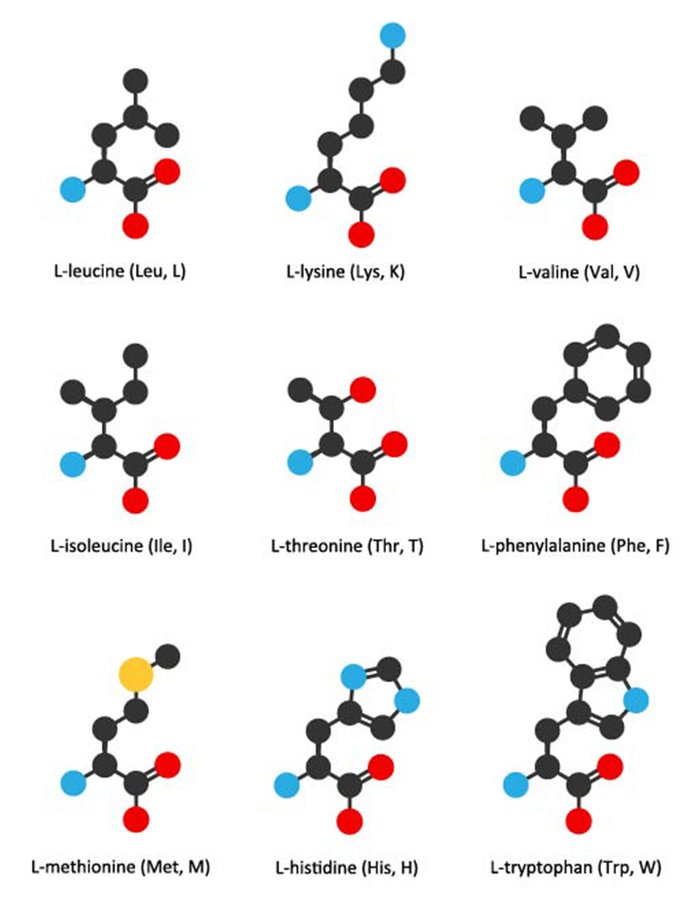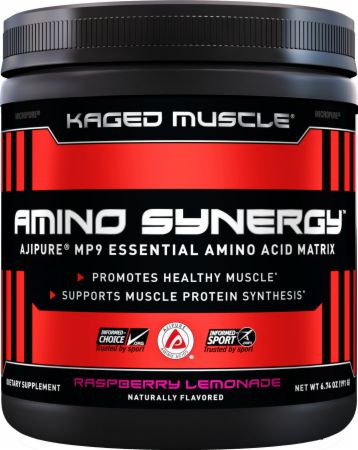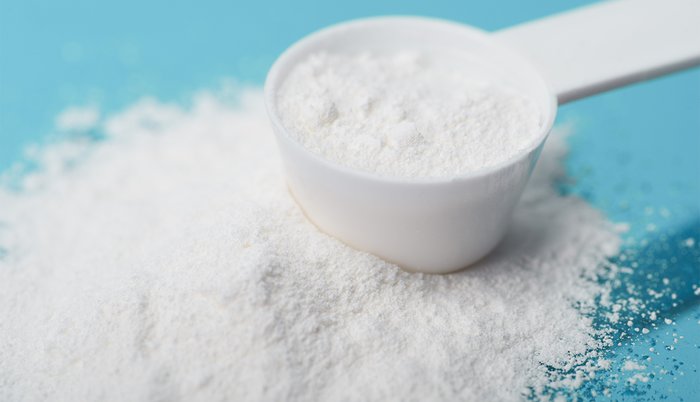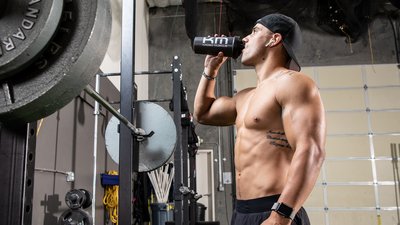For regular lifters—and a whole lot of other people these days—protein is probably the most prioritized macronutrient. Gym rats were decades ahead of the curve on protein, and the reason why was never a secret: Protein forms essential components of muscle, as Dwayne Jackson, Ph.D., explains in the article "What Does Protein Actually Do In Your Body?"
But here's one other thing lifters have been ahead of the game on: the knowledge that when they eat all protein, all the time, they can still obtain some of the benefits of protein by taking the amino acids that protein is made of.
No, I'm not going to jump into a discussion of the merits of branched-chain amino acids here. Why not? Because more research is indicating that those three aren't where the story should end. There are nine essential amino acids (EAAs) in proteins—not just three—which your body can't make on its own. And though it might seem like EAA supplements are new to the scene, there's actually extensive research looking at their effects on promoting muscle protein synthesis.
Here's a quick primer on the essential amino acids (EAAs), with the bodybuilder, lifter, or other hard-training athlete in mind.
Meet the Essential Nine
L-Leucine is one of the three BCAAs; it's integrally involved in muscle protein synthesis and acts as an activator of mTORC1. It's the amino that gets the most press, and with good reason.
L-Lysine is involved in growth, tissue repair, and nutrient uptake.
L-Valine is one of the three BCAAs; it promotes muscle growth and tissue repair.
L-Isoleucine is one of the three BCAAs. It's involved in hemoglobin synthesis and regulation of blood sugar and energy levels.
L-Threonine is involved in the creation or synthesis of protein in the body.
L-Phenylalanine plays a role in the synthesis of amino acids. It's also a precursor for important hormones such as dopamine, epinephrine, and norepinephrine.
L-Methionine is required for tissue growth and repair.
L-Histidine is involved in the synthesis of proteins. It also combines with beta-alanine to form the dipeptide carnosine.
L-Tryptophan is involved in the synthesis of proteins. It's a precursor for the neurotransmitter serotonin and the hormone melatonin.

You Can't Get Muscle Without Muscle Protein Synthesis
I don't expect you to look at that list and understand everything. But one of the key themes that should pop out is that many of the essential amino acids are involved in protein synthesis—and not just the three branched-chain amino acids. They do this through their ability to activate the mammalian target of rapamycin complex 1 (mTORC1). If you're a serious student of muscle, you may have heard of the mTOR pathway. Well, mTORC1 includes not only mTOR, but also several additional processes that stimulate muscle protein synthesis.
The mTORC1 pathway controls the anabolic and catabolic signaling of skeletal muscle mass, regulating muscle growth and muscle breakdown. And research has shown that supplementing essential amino acids in conjunction with resistance training has an additive effect on stimulating muscle protein synthesis through this pathway compared to just resistance training.[1,2]
The translation for you: Essential amino acids can help maximize the hard work we put in at the gym to stimulate muscle protein synthesis. If you're stimulating muscle protein synthesis you put yourself in a favorable position to gain muscle or at least not break down your existing muscle.

When Looking to Supplement With EAAs, Check For These Key Features:
All Nine Essential Amino Acids: While conditionally essential and nonessential amino acids play important roles in the body, studies have shown that ingestion of nonessential amino acids is not necessary to stimulate muscle protein synthesis. So, supplement for your goals, and let your diet handle the rest! Essential amino acids are primarily responsible for the amino acid-induced muscle protein anabolism.[3] Just make sure the essential amino acids are prioritized in your EAA supplement over other types of amino acids, especially over those which aren't involved in protein synthesis on the list above.
From Fermented and Vegan-Friendly Sources: Amino acids can be derived from numerous sources usually through three ways: hydrolyzation, chemical synthesis, and fermentation. One of the primary reasons for opting for amino acids that are from fermented and vegan-friendly sources is that amino acids can be derived from, shall we say, less than desirable sources such as pig fur and duck feathers.[4] In addition, non-fermented amino acids come with other potential disadvantages such as a higher risk of containing heavy metal byproducts.[5]
Little or No Artificial Colors: Artificial colors in food are a controversial topic because of their proposed links to undesirable effects. Yes, it's hard to cut these out entirely given how omnipresent they are these days, but considering these dyes offer no known nutritional value, it makes sense to skip them if you see them.
How to Use EAAs Around Training to Stimulate Muscle Protein Synthesis
Most of the research data shows that you only need around 6 grams of EAAs around training to promote muscle protein synthesis. But on the flipside, a reduction in amino acid availability below base levels can inhibit muscle protein synthesis.[6] So prioritizing these aminos, both in the foods you eat and the supplement you take, is a no-brainer.

Most high-quality pre-workout and intra-workout formulas will already contain BCAAs, leaving EAAs as the perfect post-workout supplement, especially for those who don't consume dairy-based protein products. Alternatively, you can use EAAs when creating your own pre- and intra-workout mixes.
If you're in a phase where you're cutting carbs, calories, or both in the name of losing fat, getting adequate dietary protein and amino acids is even more important.
Kaged Products
References
- Tipton, K. D., Borsheim, E., Wolf, S. E., Sanford, A. P., & Wolfe, R. R. (2003). Acute response of net muscle protein balance reflects 24-h balance after exercise and amino acid ingestion. American Journal of Physiology-Endocrinology and Metabolism, 284(1), E76-E89.
- Børsheim, E., Tipton, K. D., Wolf, S. E., & Wolfe, R. R. (2002). Essential amino acids and muscle protein recovery from resistance exercise. American Journal of Physiology-Endocrinology and Metabolism, 283(4), E648-E657.
- Volpi, E., Kobayashi, H., Sheffield-Moore, M., Mittendorfer, B., & Wolfe, R. R. (2003). Essential amino acids are primarily responsible for the amino acid stimulation of muscle protein anabolism in healthy elderly adults. The American Journal of Clinical Nutrition, 78(2), 250-258.
- Huang, J., Nkrumah, P. N., Appiah‐Sefah, G., & Tang, S. (2013). Authentication of Pure L‐Leucine Products Manufactured in China by Discriminating between Plant and Animal Sources Using Nitrogen Stable Isotope Technique. Journal of Food Science, 78(3), H490-H494.
- D'Este, M., Alvarado-Morales, M., & Angelidaki, I. (2018). Amino acids production focusing on fermentation technologies–A review. Biotechnology Advances, 36(1), 14-25.
- Wolfe, R. R. (2002). Regulation of muscle protein by amino acids. The Journal of Nutrition, 132(10), 3219S-3224S.

